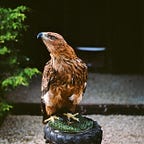Film Spotlight – Fujifilm Velvia 50
A gorgeous slide film. Give it enough of the right kind of light and it will reward you with beautiful photographs.
Most people wouldn’t touch slide film with a barge pole. And to be fair to them I can see why. It costs a lot of money to buy, hardly anyone processes E6 anymore, and then you need to get your film scanned and then mounted into slides.
When I first started out shooting film I used to read Ken’s site. Ken was a big proponent of slide film. I excitedly loaded a roll and headed out to the Lake District in Autumn, probably the worst season for extreme lightning, and came back with a lot of very contrasty photos.
Overall the cost is going to be around £35–38 per 36 exposure film (Velvia 50 is £17 a roll, Kodak E100 is £20 a roll!) So £1 per frame is not to be sniffed at, and before you pull the trigger, you’d better make sure of two things:
- The light is right for slide film
- You have metered your frame correctly (use a light meter and meter for the highlights)
The Right Light
To get a good result with slide film, you need to expose it to the right kind of light, his means enough light to expose it properly – this is a light hungry ISO50 film – and a scene which doesn’t have too much inherent contrast between the dark and light parts of the frame. Negative film is very accommodating, but slide film is a lot more like an early digital sensor, with little exposure latitude. If you are using Velvia to capture landscapes where part of the frame includes the horizon, you will likely need to employ Neutral Density filters to reduce the inherent contrast between the sky and the land / sea. Lee filters make some excellent filters, but they are expensive – I bought some cheaper ones from SRB photographic in the U.K.. Cokin & Hoya also make good ND filters.
Meter for the Highlights
It is very easy to overexpose slide film, and if you’re using an incident meter such as the Sekonic L758, meter your subject with the bulb out, highlights are easily blown out, so meter for the highlights and accept that you will have some dark areas in your frame.
I took a roll on my honeymoon to Italy which was in the month of May, and gave it some pretty whacky lighting, the best results were with axis lighting (never shoot into the sun unless you like silhouettes). Slide films work best with diffused light. If you’re having to squint, the light is probably too contrasty to give you good results.
Here are a few shots, with notes so you can see the details:
Daylight outdoor film
If the sun has gone down or you’re indoors next to anything other than a brightly lit window, think about using a different kind film, maybe Kodak Portra 400 which pushes well, or if you like to push black and white film try Ilford HP5.
If you’re planning to show your slides directly, you will need to employ a warming filter on the front of your camera – 81A or 82A or 82C is recommended by Fujifilm.
Going….going….Gone!
Fujifilm has no real love for film anymore – it should probably change its name to Fujidigital – therefore I wouldn’t be surprised to see Velvia 50 discontinued in the near future. If you’ve not tried it yet, grab a few rolls, put them to work this summer and enjoy the super-saturated, high contrast results that only slide film can provide. Just make sure everything is in the light or in the shade, and meter your subject with the bulb out. Have fun!
If you’ve found this interesting or useful, gave a look at some other film related articles:
